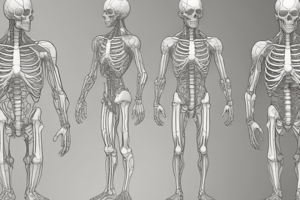Podcast
Questions and Answers
During which stage of the cardiac cycle do the ventricles fill with blood?
During which stage of the cardiac cycle do the ventricles fill with blood?
- Isovolumetric contraction
- Isovolumetric relaxation
- Filling phase (correct)
- Outflow phase
What occurs at the end of diastole?
What occurs at the end of diastole?
- The ventricles contract
- The atria contract (correct)
- The ventricles relax
- The atrioventricular valves open
What is the result of isovolumetric contraction?
What is the result of isovolumetric contraction?
- Blood flows from the ventricles into the aorta
- The atrioventricular valves open
- Blood flows from the ventricles into the atria
- The pressure within the ventricles increases (correct)
During which stage of the cardiac cycle do the ventricles relax?
During which stage of the cardiac cycle do the ventricles relax?
What happens to the atrioventricular valves at the end of diastole?
What happens to the atrioventricular valves at the end of diastole?
What is the duration of isovolumetric contraction?
What is the duration of isovolumetric contraction?
What happens to the ventricles' pressure during filling phase?
What happens to the ventricles' pressure during filling phase?
What is the purpose of atrial systole?
What is the purpose of atrial systole?
During which phase does the blood flow from the ventricles into the aorta and pulmonary trunk?
During which phase does the blood flow from the ventricles into the aorta and pulmonary trunk?
What is another name for the outflow phase?
What is another name for the outflow phase?
Flashcards are hidden until you start studying
Study Notes
The Cardiac Cycle
- The cardiac cycle consists of four stages: filling phase, isovolumetric contraction, outflow phase, and isovolumetric relaxation.
Filling Phase
- The ventricles fill with blood in two stages: diastole (heart relaxation) and atrial systole (contraction of the atria).
- During diastole, both atria and ventricles are relaxed, and blood flows from vena cava and pulmonary veins into the atria, then directly into the ventricles.
- The ventricles fill with blood at a steadily decreasing rate until the ventricles' pressure is equal to that in the veins.
- At the end of diastole, the atria contract, squirting a small amount of extra blood into the ventricles, increasing the ventricles' pressure.
Isovolumetric Contraction
- Contraction begins with both sets of valves closed, increasing pressure within the ventricles, ready to eject blood into the aorta and pulmonary trunk.
- This stage lasts for approximately 50ms, during which the pressure builds up.
Outflow Phase
- Once the ventricles' pressure exceeds the pressure in the aorta/pulmonary trunk, the outflow valves (aortic/pulmonary) open, and blood is pumped from the heart into the great arteries.
- The outflow phase lasts for around 330ms.
- At the end of systole, the ventricles begin to relax, decreasing ventricular pressure compared to the aorta, causing the outflow valves to close.
Isovolumetric Relaxation
- At the end of the outflow phase, both sets of valves are closed, and the ventricles begin to relax, reducing the pressure in the ventricles so that the atrioventricular valves open.
- The ventricles then begin to fill with blood, and the cycle begins again.
Studying That Suits You
Use AI to generate personalized quizzes and flashcards to suit your learning preferences.




